Purdey No. 8142 Visits Nebraska’s Bohemian Alps
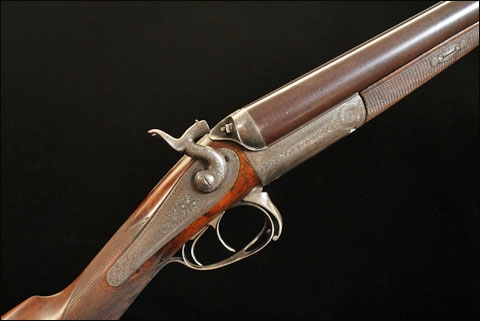
This past October we visited my wife’s sister and brother-in-law in central Nebraska. I was a willing participant. I love my extended family, I love visiting that part of my country and I had a selfish motive: shooting at the Oak Creek Sporting Club in Brainard, Nebraska with a pristine thumb lever Purdey built in 1869 loaned to me by a friend. Shooting a classic British shotgun in the heart of the New World intrigued me.
Oak Creek is located in so-called “fly over” America that I find enriching and rejuvenating. It’s that part of America where you see billboards advertising businesses such as “Bill’s Fine Dining, Plumbing and Tires” and you hope Bill has kept the components of each business separate from the others. Brainard is a few miles from Loma, the diminutive town where much of the somewhat cultish movie “To Wong Foo, Thanks for Everything Julie Newmar” (1995) was filmed, starring John Leguizamo, Wesley Snipes and Patrick Swayze.
Oak Creek resides in the larger geographic area known as the Bohemian Alps, a designation derived from the fact that the area was settled primarily by Czech immigrants. The region boasts lush farmland and gently rolling hills planted with alfalfa, milo, wheat and corn, which on the day of my visit, showed like a patchwork quilt of pastel shades of green and brown as far as my eyes could see.
This is big country, inhabited by big things: big trains, big trucks, big skies and, from what I have experienced, big hearts. Real blue jeans are worn and faded and made threadbare from real work and boots are scuffed and cut on real iron, rock and concrete. It’s where the amber waves of grain wave and it’s the home of the fruited plains some of us still sing about.
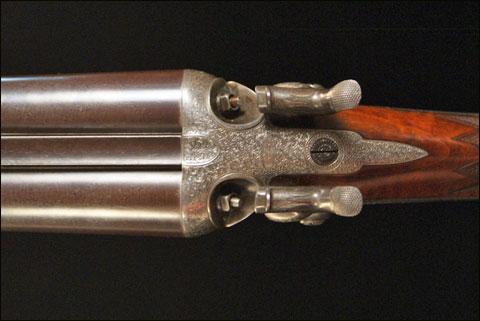
The stunning workmanship on Purdey No. 8142.
The Purdey No. 8142
The Purdey loaned to me was a 12-bore back-action Island Lock hammer gun, serial number 8142, made in 1869. It has 2½-inch chambers rated at 3 tons of pressure, 30-inch Damascus barrels with interior diameters of 0.740 inches and is choked cylinder and cylinder. It features a No. 2 thumb lever snap-action and non-rebounding hammers. This jewel of a shotgun boasted being in original condition, accompanied by its original leather case with original cleaning rod and all support items, such as powder and shot measuring devices. The words “James Purdey” are engraved on its original oil bottle. Often the trade label within the lid of a gun case has the serial number of the gun written in pencil to identify the case as belonging to a specific gun. The trade label in this original case has the pencil marking of the gun’s serial number.
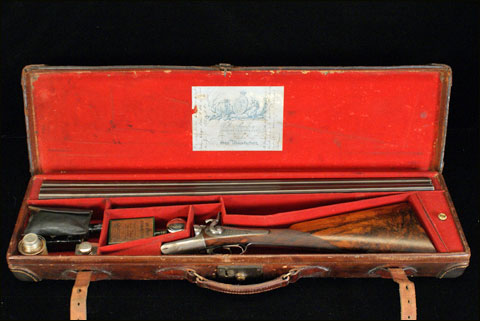
The Purdey as it was originally shipped from the factory.
Prior to traveling to Oak Creek I researched the Purdey provenance and its thumb lever action at Mark Reynolds’ fine library of firearms books at his store, M. W. Reynolds, in Englewood, Colorado. Mark also took photographs of the shotgun. As expected, the knowledge added richness to my shooting experience.
A few words on the 8142’s history will be clarifying for the reader. This information comes from the encyclopedic volume, The British Shotgun 1850-70, by I.M. Crudgington and D.J. Baker. James Purdey & Sons – or simply “Purdey”—is, arguably, the most prestigious name in sporting arms around the world, the name being synonymous with the finest sporting shotguns and rifles.
James Purdey founded James Purdey & Sons Limited in London, England in 1814, locating his business on Princes Street. Prior to starting out on his own, Purdey worked as head stocker for Joseph Manton, the foremost gunmaker of his time. In 1826 the company moved from the Princes Street location to Manton’s former premises in Oxford Street. Purdey designs progressed from muzzle loading flintlocks in the 1820s to breech loading hammerless ejectors by the 1880s. Purdey’s hammerless self-opening mechanism was designed by Frederick Beesely, a Purdey worker of the time. It used one limb of a V spring to operate the internal hammers and the other to operate the self-opening feature.
Before the adoption of the Scott spindle Purdey used several other methods of working their sliding bolt. Probably the earliest is that which a lever is pivoted towards the front of the action bar and is carried to the rear to curve partway around the trigger guard. This latter is made unusually broad at the front to permit an opening to be made in it wide enough so that a user of the gun can insert his thumb to press down the opening lever. Hence the term “thumb hole action” which has come to be applied to these guns. Above the pivot is an upward projection of the lever which enters a slot in the slide so that, as the lever is thrust down, the slide is pushed to the rear.

The legendary Purdey Long Room as it appeared in 1882.
Purdey’s patent number 8372 was for the second pattern thumb hole action, the action featured on my friend’s shotgun. This second mode of operating the bolt, which is perhaps more widely seen, is also a thumb-hole action. This time a shorter lever is used which is pivoted above the front of the trigger guard, and but a single spring which has two limbs, rather like a tuning fork, and lies backwards in either side of the trigger work.
Purdey holds or has held numerous warrants of appointment as gun and rifle makers to the British and other European royal families. Purdey was granted its first Royal Warrants in 1868 by The Prince of Wales, later King Edward VII. Presently, the company holds warrants from HM The Queen, HRH The Duke of Edinburgh and HRH The Prince of Wales.
The Purdey No. 8142 at Oak Creek
Oak Creek Sporting Clays is a full-service shooting facility, offering a rifle and pistol range, a challenging five-stand facility, skeet and trap ranges and two sporting clays courses. It offers pheasant, chukar and turkey hunting in season. Oak Creek hosts many tournaments including the Nebraska State Sporting Clays Championships as well as many fund-raising shoots for an array of charities. I’d been shooting at Oak Creek for almost a decade. I consider the Kriz family as friends. The six Kriz family members have owned the club for about fifteen years. Slowly and meticulously they have transformed a small section of farmland into a high-end shooting facility and hunting preserve.
We parked near the clubhouse. Me and Erik, my son, went inside to meet Terry and his brother Tim to orchestrate the day’s shooting. We started at the challenging five-stand course. I took my Beretta over / under from my Negrini case and then delicately uncased the Purdey.
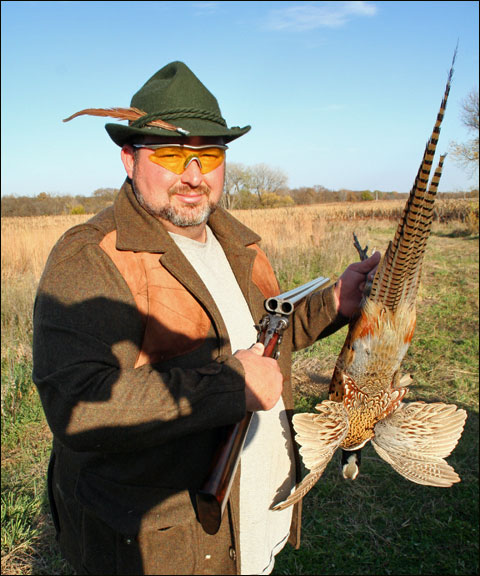
Terry Kriz took a pheasant with Purdey No. 8142.
“I’ve worked at this range for ten years or so,” Terry said as he held the Purdey as carefully as one would hold a newborn child, “and I’ve never seen a shotgun like this. This is great! Thanks for bringing it to my club.”
I selected an array of RST low-pressure 2½-inch cartridges to use for the clay targets. For my modern Beretta I used Fiocchi Little Rino ammunition. We all took turns shooting the Purdey, and all of us enjoyed admirable success. It took me several shots to remember to operate the thumb lever instead of reaching for the non-existent top lever. One particularly troublesome clay was a mini rocketing out toward the New Jersey Turnpike, yet was crushed consistently by Erik and Terry. Achieving success with such an aged masterpiece was exhilarating and gratifying.
No. 8142 Used as Intended
Tim had released a half dozen or so pheasant into a field of corn stubble not too far from the road leading to the clubhouse. I held the Purdey, checking to see that the non-rebounding hammers were pulled back a quarter to the “safe” position, also the position for opening and closing the gun. I had selected RST 1-ounce, 2 ½ inch cartridges that propelled the #5 shot at 1,175 feet per second at the muzzle.
We walked a few hundred yards into the field, accompanied by Tim’s rambunctious Lab that bounded about like a porpoise over the waves. The fragrance of the damp earth was a joyous perfume and when the air was quiet the luscious aroma of my Galco bridle leather speed bag tickled my nostrils. The quiet and the 360-degree beauty of the field hit like hammers. Already the rewards of the day had been considerable.

Tim Kriz shooting the Purdey.
Then the Lab froze like a statue. We tip-toed toward the dog. I handed the Purdey to Terry, giving him the honor of firing the first shot. Crouched like a panther ready to strike, the Lab took another step, slow and focused, nose parallel to the ground. Then another step. A pheasant rocketed toward the clouds. Terry gracefully maneuvered the Purdey and fired. The bird dropped like a weight at the gym. His success reminded me of the often spoken comment by Steve Comus, editor of Safari Magazine: “When you make a beautiful shot with a beautiful gun, for that moment, all is right with the world.”
Terry handed the Purdey to Tim. We walked a few moments and another pheasant shot out, a sharp left to right crossing target. The first barrel missed; the second dropped the bird expertly. Tim handed the Purdey to Erik . We walked further into the field. A pheasant erupted from our right, crossing high and to our left. Erik smoothly shouldered the Purdey but stopped his swing. Tim had managed to walk a few steps ahead and to the left of Erik and into the line of fire on Erik’s extreme left edge. Erik pulled the gun up. I congratulated him on his self-control and selflessness. Another bird flushed but was too distant to take a shot. We walked about for another fifteen minutes or so but were unsuccessful in raising any birds.

Terry Kriz shows the pheasant he landed with Purdey No. 8142.
Using this magnificent shotgun as it was crafted and intended to be used was, in my experience, a rare joy. The Purdey, in its day and to this day, is a racehorse in the stable of the world’s sporting arms. Slim, elegant and infused with artistic grace, Purdey No. 8142 moves as effortlessly as a maestro’s baton, evoking in my mind Aristotle’s notion of beauty: nothing to be added and nothing to be taken away.
Holding Tradition in Your Hands
My writing about and general interest in vintage English shotguns and the Edwardian period has bestowed upon me some knowledge of the shooting events in England and the personalities that did the shooting during the period. Thus, thoughts of the provenance and possible users and handlers of this Purdey careened in my mind like a downhill skier fighting to maintain control. No doubt this Purdey was shot by business moguls and, almost assuredly, by royalty.
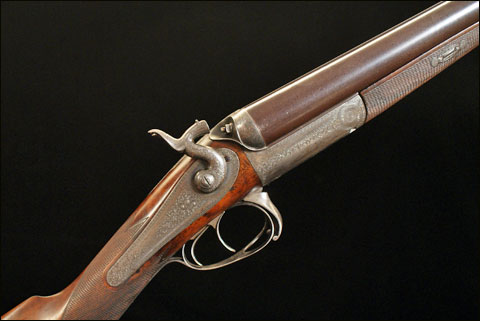
The Purdey No. 8142.
Did this Purdey in my hands bring down pheasant at the great shooting estates of Sandringham, Merton, Elveden, Hall Barn or Holkham, among others? Did the greatest shooters of the Edwardian era, Lords Ripon and Walsingham, perhaps bring down a pheasant or two with this very shotgun? Did King George or King Edward VII shoot it or ask the gun’s owner, “Can I take a look?” and then mutter, “Nice gun!!” My mind reeled.
The modern guns, my Beretta for example, are extraordinary sporting arms, boasting the best steel and greatest reliability. And, of course, Beretta, specifically, has been in the gun trade for five hundred years, give or take a weekend or two. But my modern Beretta, as with all modern guns, was not, by definition, drenched in history as was the Purdey in my hands. Like a violin string resonating across generations, this No. 8142 linked the past to the present. It links a past when, in the firearms trade, at least, the finest craftsmanship in the world was done, not with CNC computers and electrospark technology but by a man’s hand, driven and impelled by skill and pride. This Purdey No. 8142 is not about tradition. It is tradition.
I am grateful to and give thanks to my unnamed colleague who graciously entrusted his extraordinary Purdey No. 8142 to me and, thereby, enabled me to bring joy to my dear friends at Oak Creek in the middle of Nebraska. In the words of Ira Gershwin, “Who could ask for anything more?”
Useful resources:
Purdey’s web site
The Oak Creek Club web site
The web site for Negrini gun cases
RST shotshells web site
Michael Sabbeth is a lawyer and a writer and lives in Denver, Colorado. He has written the acclaimed book, The Good, The Bad & The Difference: How to Teach Values to Children, available at www.amazon.com He is now writing a book titled The Honorable Hunter: Defending and Advancing Our Hunting Heritage. The book will show how to make the best arguments to advance hunting and the shooting sports and how to defend and refute unwarranted attacks against them. He can be contacted at author@makeyourcasehuntshoot.com

Michael Sabbeth is a lawyer in Denver, Colorado. He lectures on ethics and rhetoric to law associations and civic and business groups. He is the author of the The Good, The Bad & The Difference: How to Talk with Children About Values. Please visit his website at www.kidsethicsbook.com.


Comments